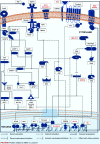Multidrug resistance in chronic myeloid leukaemia: how much can we learn from MDR-CML cell lines?
- PMID: 24070327
- PMCID: PMC3839595
- DOI: 10.1042/BSR20130067
Multidrug resistance in chronic myeloid leukaemia: how much can we learn from MDR-CML cell lines?
Abstract
The hallmark of CML (chronic myeloid leukaemia) is the BCR (breakpoint cluster region)-ABL fusion gene. CML evolves through three phases, based on both clinical and pathological features: a chronic phase, an accelerated phase and blast crisis. TKI (tyrosine kinase inhibitors) are the treatment modality for patients with chronic phase CML. The therapeutic potential of the TKI imatinib is affected by BCR-ABL dependent an independent mechanisms. Development of MDR (multidrug resistance) contributes to the overall clinical resistance. MDR involves overexpression of ABC -transporters (ATP-binding-cassette transporter) among other features. MDR studies include the analysis of cancer cell lines selected for resistance. CML blast crisis is accompanied by increased resistance to apoptosis. This work reviews the role played by the influx transporter OCT1 (organic cation transporter 1), by efflux ABC transporters, molecules involved in the modulation of apoptosis (p53, Bcl-2 family, CD95, IAPs (inhibitors of apoptosis protein)], Hh and Wnt/β-catenin pathways, cytoskeleton abnormalities and other features described in leukaemic cells of clinical samples and CML cell lines. An MDR cell line, Lucena-1, generated from K562 by stepwise exposure to vincristine, was used as our model and some potential anticancer drugs effective against the MDR cell line and patients' samples are presented.
Figures


Similar articles
-
TCF7 knockdown inhibits the imatinib resistance of chronic myeloid leukemia K562/G01 cells by neutralizing the Wnt/β‑catenin/TCF7/ABC transporter signaling axis.Oncol Rep. 2021 Feb;45(2):557-568. doi: 10.3892/or.2020.7869. Epub 2020 Nov 27. Oncol Rep. 2021. PMID: 33416164 Free PMC article.
-
Targeting Hedgehog signaling pathway and autophagy overcomes drug resistance of BCR-ABL-positive chronic myeloid leukemia.Autophagy. 2015;11(2):355-72. doi: 10.4161/15548627.2014.994368. Autophagy. 2015. PMID: 25701353 Free PMC article.
-
Antibiotic anisomycin selectively targets leukemia cell lines and patient samples through suppressing Wnt/β-catenin signaling.Biochem Biophys Res Commun. 2018 Nov 2;505(3):858-864. doi: 10.1016/j.bbrc.2018.09.183. Epub 2018 Oct 6. Biochem Biophys Res Commun. 2018. PMID: 30301525
-
Characterization of cancer stem cells in chronic myeloid leukaemia.Biochem Soc Trans. 2007 Nov;35(Pt 5):1347-51. doi: 10.1042/BST0351347. Biochem Soc Trans. 2007. PMID: 17956348 Review.
-
OCT1 and imatinib transport in CML: is it clinically relevant?Leukemia. 2015 Oct;29(10):1960-9. doi: 10.1038/leu.2015.170. Epub 2015 Jul 9. Leukemia. 2015. PMID: 26122430 Review.
Cited by
-
Tendency of K562 Chronic Myeloid Leukemia Cells Towards Cell Reprogramming.Turk J Haematol. 2018 Nov 13;35(4):260-264. doi: 10.4274/tjh.2018.0106. Epub 2018 May 21. Turk J Haematol. 2018. PMID: 29781803 Free PMC article.
-
Pharmacogenomics of Impaired Tyrosine Kinase Inhibitor Response: Lessons Learned From Chronic Myelogenous Leukemia.Front Pharmacol. 2021 Jun 28;12:696960. doi: 10.3389/fphar.2021.696960. eCollection 2021. Front Pharmacol. 2021. PMID: 34262462 Free PMC article. Review.
-
Proteomic Dynamics of Multidrug Resistance Mechanisms in Lucena 1 Cell Line.Cells. 2024 Aug 26;13(17):1427. doi: 10.3390/cells13171427. Cells. 2024. PMID: 39272999 Free PMC article.
-
Dysregulation of LINC00470 and METTL3 promotes chemoresistance and suppresses autophagy of chronic myelocytic leukaemia cells.J Cell Mol Med. 2021 May;25(9):4248-4259. doi: 10.1111/jcmm.16478. Epub 2021 Mar 21. J Cell Mol Med. 2021. PMID: 33749070 Free PMC article.
-
Detachment of Hexokinase II From Mitochondria Promotes Collateral Sensitivity in Multidrug Resistant Chronic Myeloid Leukemia Cells.Front Oncol. 2022 May 26;12:852985. doi: 10.3389/fonc.2022.852985. eCollection 2022. Front Oncol. 2022. PMID: 35719932 Free PMC article.
References
-
- Jabbour E., Kantarjian H. Chronic myeloid leukemia: 2012 update on diagnosis, monitoring, and management. American J. Hematol. 2012;87:1037–1045. - PubMed
-
- Faderl S., Kantarjian H. M., Talpaz M. Chronic myelogenous leukemia: update on biology and treatment. Oncology (Williston Park, NY) 1999;13:169–180. discussion 181, 184. - PubMed
-
- Nowell P. C., Hungerford D. A. Chromosome studies on normal and leukemic human leukocytes. J. Natl. Cancer Inst. 1960;25:85–109. - PubMed
-
- Kurzrock R., Gutterman J. U., Talpaz M. The molecular genetics of Philadelphia chromosome-positive leukemias. New Engl. J. Med. 1988;319:990–998. - PubMed
Publication types
MeSH terms
Substances
LinkOut - more resources
Full Text Sources
Other Literature Sources
Medical
Research Materials
Miscellaneous

